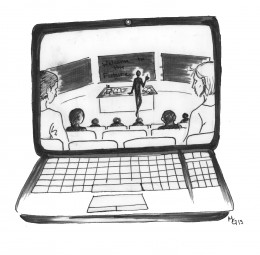
Distance learning, as the name implies, is technology that allows classes to be taught not in physical lecture halls with students physically populating its seats, but online instead, with professors recording videos of their lectures, then posting them to a class website.
The advantage of widespread distance learning is not hard to see: Rather than having to drag themselves out of bed in 10-degree weather for 8 a.m. classes, students could watch the lectures at leisure and, more than that, could rewatch the parts they missed — not an unlikely occurrence at 8 a.m.
The convenience factor, then, is perhaps the most obvious aspect added by distance learning. Professors, too, could benefit from distance learning. Not only could they teach from the luxury of their own homes, but they would no longer have to deal with the perpetual disturbances that plague the classroom — latecomers to class, cell phones going off, the two students invariably talking and giggling throughout class.
But if convenience is an obvious benefit, it’s also easy to see what could be lost by pushing the learning experience online. No longer would there be a shared environment in which students and professors could engage. No longer could the professors — the good ones, at least — hold the students rapt with their words. The learning process would be, in some way, sterilized. We have seen already, through a slew of evidence, that quantity, not quality, of interaction makes us happy, and that online interaction, while plentiful, lacks the quality of face-to-face dialogue.
But school administrators should be wary. Distance learning can be a powerful tool. It can deepen and ease the learning process, and make getting to the right answer simpler. However, there are subjects in which the efficacy of that is more obvious than in others. STEM (Science, Technology, Engineering and Math) classes are ones in which there are right and wrong answers. Students work and struggle to get to x, whatever it may be. Lectures can be bogged down by students who just don’t get it.
If students were to watch lectures online, then come into class knowing what questions they had, and lectures were instead question-and-answer sessions — or were instead replaced with more discussion sections — our STEM classes could be made far more efficient.
But in subjects like political science, English and anthropology, the right answer is not so set in stone. Class is about discussion — finding an answer together. Taking the discussion, the interpersonal aspect of learning, away — that is dangerous. While distance learning is still relatively untested, it’s hard to see an easy way to apply it to the liberal arts.
Distance learning holds promise, that much is certain. It stands above the cold discussion boards and text-only online classes that dominate e-learning today. But at least so far, they are a far cry from physical lectures. There are far-flung applications to distance learning — say, professors holding office hours on Skype — but we must stay constantly vigilant that we are not losing in interpersonal and creative learning what we are gaining in convenience.


